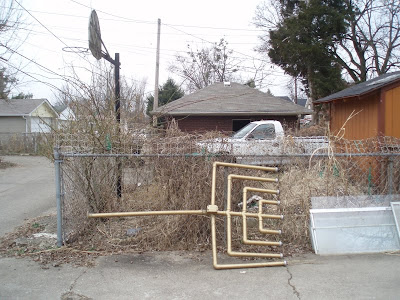Elizabeth Barton had an
interesting blog post this week about how artists should go about setting and achieving their goals. Her last point was that people need to experiment, but then need to assess what they have done and decide whether the experiment got them toward their goal or just took them around in circles.
This comment resonated with me because it fits in with the whole idea of finding your voice and not getting seduced off on tangents, which I commented on in the context of attending workshops. But tangents offer themselves in many other contexts as well – looking at people’s blogs, seeing other people’s work in a show or magazine, reading a new book. And too many times those tangents do not accomplish much except to take up time and produce work that may be nice, but doesn’t really get you closer to your goal.
I’m not saying that you must never take a tangent. Sometimes you need to take a little vacation from your real work. It can be emotionally refreshing to make the baby quilt, organize the wedding, sew up valentine hearts, whip out 50 sheets of handmade paper, practice some calligraphy, help your friend dye a bunch of fabric. But I don’t count that as art time, the time you are investing in your serious goals.
That’s a tangent. Back to my original point – that you need to assess what you have done. Elizabeth was talking about experimental work, but I will broaden the discussion and suggest that you need to assess everything you have done, and it’s more important to assess your “real” work than your tangents.
Sometimes people ask how you go about working in series – do you sketch out in advance what your next five pieces are going to look like? If not, how do you figure out what to do next?
As an aficionada of series, let me tell you my approach, and what I advise others to do.
After I finish a quilt, I ask myself four questions:
1. What do I like about this piece?
2. What do I not like?
3. What parts of it were easy to execute, and what was hard?
4. Where did I make choices between equally appealing alternatives?
Then I use the answers as a plan for the next work in the series.
1. Repeat some or all of what I liked.
2. Eliminate what I didn’t like.
3. Think of ways to make the hard parts easier, or avoid them.
4. Try one of the other alternatives that I didn’t choose the first time.
I try to be as specific and as rigorous as possible. For instance, my most recent big works were the two quilts that I sent off to Color Improvisations. I can’t show you the full pictures yet (we’re sworn to secrecy till the show opens in July) but I can share detail shots and my assessment of one of them, “Fault Lines 3.” The quilt is 74 x 76 inches. What you see in the larger detail shot is less than one-quarter of the quilt.

1. I like the complexity of the line work, the quilting was probably the best I’ve done in my life, I like the huge scale, I got a new burst of enthusiasm over the “Fault Lines” series.
2. The color choice could have been better; not sure I like the placement of accent colors achieved with quilting threads; I wish I had stirred the dye bath more so the back of the quilt was less mottled and more uniform in color.
3. It was surprisingly easy to piece, despite being huge, but very difficult and time-consuming to quilt.
4. I used four shades of red, ranging from light-medium to very dark. I could have used more than one color, or more variety in value, or less variety in value. I quilted each segment of the piece with a separate design rather than use an allover plan, and changed the quilting color occasionally for accent.
Having evaluated the quilt, so what? Now I use the answers to those four questions as a road map to the next quilt.
1. I will do the complex line work again in another huge “Fault Lines” quilt.
2. I will do more careful planning of colors, especially the accent color of the quilting thread.
3. I will quilt it in two panels and join them at the end, rather than struggle with one huge piece.
4. I will use more than one color. I might choose a different design approach to the quilting, and might not use a quilting thread accent color.
I should point out that I love this quilt; it’s one of the best pieces I’ve done. But I still can notice and evaluate the things that weren’t 100% successful, or that I could have done better. Indeed, you could argue that it’s more important to be rigorous in evaluating your best work than in evaluating your mediocre work. You raise the bar by exceeding your best rather than just exceeding your merely OK.
If you are working in series, or thinking about working in series but not sure how to proceed, this is a method that may help you along. Feel free to try it, and let me know how it works for you.
























































